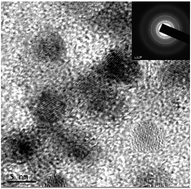CuInS2–In2Se3 quantum dots – a novel material via a green synthesis approach†
Abstract
Novel CuInS2–In2Se3 QDs were prepared by a two stage organometallic colloidal synthesis procedure. A layer of indium selenide was grown over the CuInS2 QD core, under high temperature in the presence of oleylamine. The optical properties of the nanostructures grown were studied using UV-Vis absorption spectroscopy and the band gap obtained was in line with the cyclic voltammetry (CV) results. The elemental composition was analysed using energy dispersive X-ray spectroscopy (EDAX), inductive coupled plasma-atomic emission spectroscopy (ICP-AES) and X-ray photoelectron spectroscopy (XPS). The structural properties were investigated using X-ray diffraction (XRD) and high resolution transmission electron microscopy (HRTEM). The TEM images showed spherical nanostructures of size about 4.8 nm with well-defined lattice planes which were also evident from selected area electron diffraction (SAED) patterns. The XRD pattern indicated a tetragonal chalcopyrite crystal structure for the nanostructures.



 Please wait while we load your content...
Please wait while we load your content...